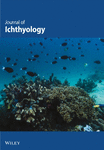Effects of maternal conditions on early life history traits of black porgy Acanthopagrus schlegeli
Abstract
This work examined the effects of maternal conditions on early life history traits of black porgy Acanthopagrus schlegeli. Age-II females produced significantly larger eggs as compared to the same size of Age-III females. Also, within each of the age groups, there was a positive relationship between egg size and female size. The larger eggs generally had larger volumes of oil globules, required longer incubation periods (hatching age), and produced larger larvae that endured longer to starvation. Hatching age was covaried negatively with yolk volume at hatching, indicating that embryonic development consumed primarily yolk as its energy resource. The condition factor, gonadosomatic index, hepatosomatic index, and lipid content of the females were not related to the early life history traits of their offspring.




